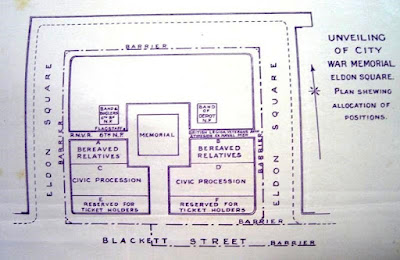On the 26th of September 2023 the Lady Mayoress of Newcastle, the City Councils' Armed Forces Champion, representatives from 5th Battalion Royal Regiment of Fusiliers, and Armed Forces Veterans gathered to commemorate the centenary of the unveiling of the Newcastle War Memorial in Eldon Square.
 |
| Centenary Eldon Square War Memorial |
At the end of the First World War, communities around the British Empire began to think about how best to remember the casualties of the conflict. The resting place for many of those who lost their lives was "a corner of a foreign field that was forever England", for thousands there was no known grave. A focus was needed where people had the opportunity to visit and remember, resulting in the building of memorials in villages, towns and cities around the United Kingdom and the world.
In Newcastle thoughts of a memorial began in December 1920 when the 'Shilling Fund' was instituted that encouraged Newcastle residents to donate 1 shilling (5 pence), worth around £1.85 today, to pay for the memorial. The memorial cost of £12,910 (£476,722 today) was raised by mid January 1921, testament to the support for the project by the people of Newcastle. In total £16,374 (£605,000 today) was raised, the surplus funds being donated to the Newcastle Royal Victorian Hospital (RVI) to provide additional beds.
The site chosen for the memorial was Eldon Square in the centre of Newcastle which was laid out in 1825-31 as an early part of Richard Grainger’s ambitious redevelopment plan for Newcastle
 |
| Eldon Square prior to WW1 |
The Newcastle memorial consists of a Portland stone pedestal 9.75 metres (32 feet) high on which a 3.36 m (11 feet 6 inches) tall bronze statue of St George and the Dragon rests. Carved into the south face would be feature the date of the conflict 1914 - 1918.
 |
| Eldon Square War Memorial post WW1 |
An inscription reads
A TRIBUTE OF AFFECTION/ TO THE MEN OF/ NEWCASTLE AND DISTRICT/ WHO GAVE THEIR LIVES/ IN THE CAUSE OF FREEDOM/ THEIR NAME LIVETH FOR EVERMORE.
Field Marshall Earl Haig unveiled the Newcastle upon Tyne City War Memorial at Eldon Square on Wednesday 26th September 1923 at 3 pm.
On parade were contingents from the Tyne Division of the Royal Naval Volunteer Reserve (RNVR), the 6th (The City) Battalion Northumberland Fusiliers (6th N.F.) and veterans from the British Legion. The bands of the Northumberland Fusiliers Depot and the 6th Battalion N.F. supported the occasion. On each corner of the memorial were sentries from representatives of the Royal Navy, Northumberland Hussars, the Northumbrian Brigade RFA and the Northumberland Fusiliers.
Following the memorials unveiling by Field Marshall Earl Haig, there was a minutes silence, followed by the playing of the 'Last Post' and 'Revile'. The Lady Mayoress then laid a wreath of red and cream roses that bore the inscription “In token of affectionate remembrance from the citizens of Newcastle upon Tyne” . Wreaths were then laid by representatives of military units followed by relatives of those who had lost their lives who came forward to pay their own tributes.
 |
Unveiling of Newcastle War Memorial
26th September 1923 |
 |
Unveiling of Newcastle War Memorial
26th September 1923 |
------O------
NEWCASTLE UPON TYNE WAR MEMORIAL
UNVEILLING
26th SEPTEMBER 1923



























.jpg)
.jpg)



















































